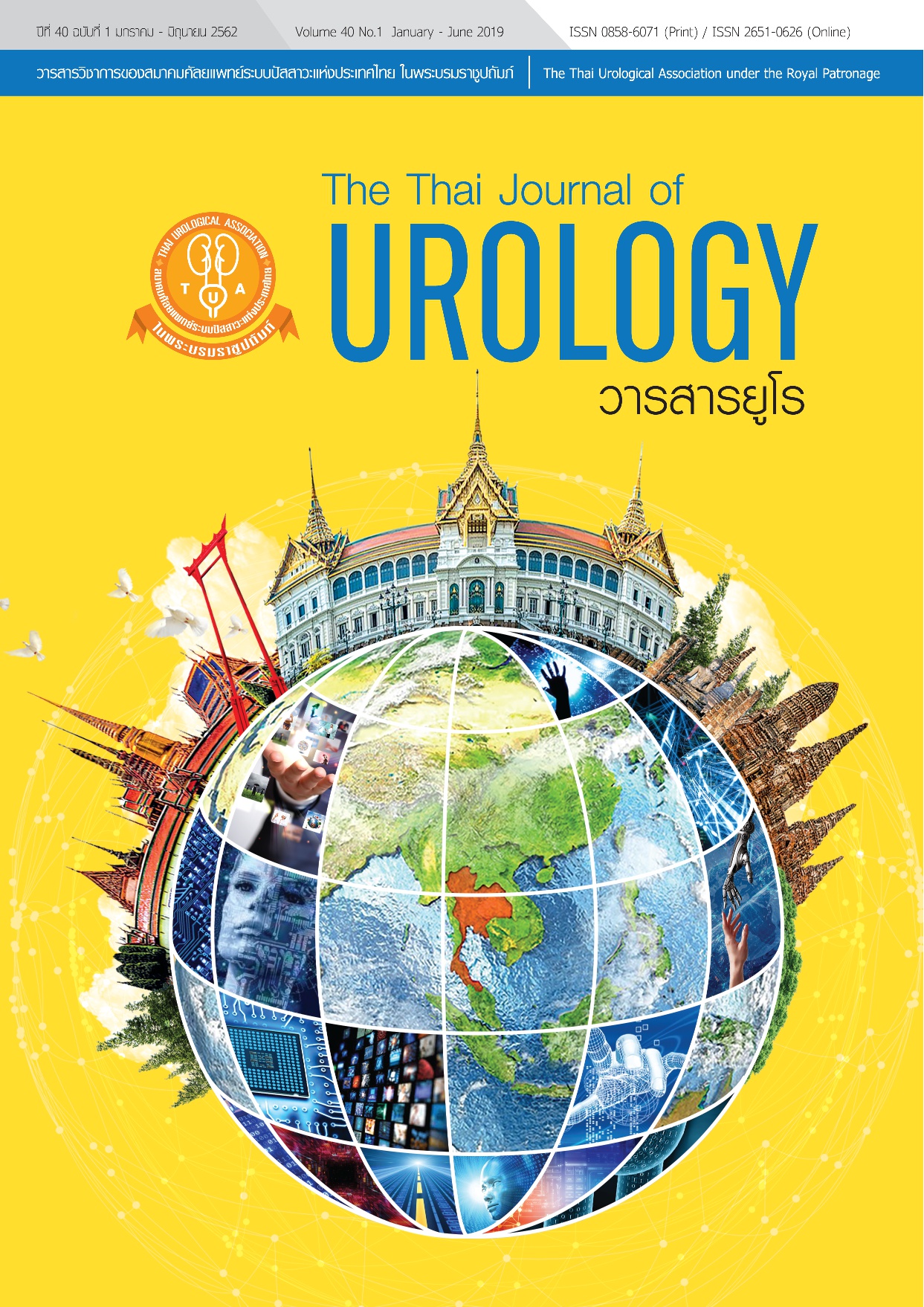Comparison of the outcomes for retrograde intrarenal surgery (RIRS) and percutaneous nephrolithotomy (PCNL) in the treatment of renal stones more than 2 centimeters
Keywords:
RIRS, FURS, PCNL, PNL, Renal calculi, large renal stoneAbstract
Objective: Comparison of the treatment of large renal stone outcomes between PCNL and RIRS.
Material and Method: Retrospective study of patients with large renal calculi who underwent stone treatment at Siriraj Hospital between July 2012 and September 2016. Patients were reviewed and divided into group I (PCNL, n=73) and group II (RIRS, n=67). The outcomes, including operating time, length of hospital stay, complications, stone-free rates and retreatment rates, were collected and compared.
Result: Stone-free rates were 79.4% in group I and 74.6% in group II (p=0.497). Retreatment rates were 53.3% in group I and 47% in group II (p=0.723), while operative time (p=0.001), length of hospital stays (p<0.001), and complications (p<0.001) were statistically different. Main stone compositions were calcium oxalate monohydrate (38%) and calcium phosphate (23%).
Conclusion: Treatment of kidney stones 2-4 centimeters in size with PCNL or RIRS was comparable with satisfactory outcomes.
References
2. De S, Autorino R, Kim FJ, et al. Percutaneous nephrolithotomy versus retrograde intrarenal surgery: a systematic review and meta-analysis. Eur Urol 2015;67:125-137.
3. Resorlu B, Unsal A, Gulec H, et al. A new scoring system for predicting stone-free rate after retrograde intrarenal surgery: the "resorluunsal stone score". Urology 2012;80:512-518.
4. Osman MM, Alfano Y, Kamp S, et al. 5-yearfollow-up of patients with clinically insignificant residual fragments after extracorporeal shockwave lithotripsy. Eur Urol 2005;47:860-864.
5. Bryniarski P, Paradysz A, Zyczkowski M, et al. A randomized controlled study to analyze the safety and efficacy of percutaneous nephrolithotripsy and retrograde intrarenal surgery in the management of renal stones more than 2 cm in diameter. J Endourol 2012; 26:52-57.
6. Tefekli A, Ali Karadag M, Tepeler K, et al., Classification of percutaneous nephrolithotomy complications using the modified clavien grading system: looking for a standard. Eur Urol 2008;53:184-190.
7. Oguz U, Resorlu B, Ozyuvali E, et al., Categorizing intraoperative complications of retrograde intrarenal surgery. Urol Int 2014;92:164-168.
8. Inoue T, Okada S, Hamamoto S, et al., Current trends and pitfalls in endoscopic treatment of urolithiasis. Int J Urol 2018;25:121-133.
9. Pradere B, Doizi S, Proiette S, et al. Evaluation of Guidelines for Surgical Management of Urolithiasis. J Urol 2018;199:1267-1271.
10. Sanguedolce F, Bozzini G, Chew B, et al. The Evolving Role of Retrograde Intrarenal Surgery in the Treatment of Urolithiasis. European Urology Focus 2017;3:46-55.
11. Kirac M, Bozkurt Of, Tunc L, et al., Comparison of retrograde intrarenal surgery and minipercutaneous nephrolithotomy in management of lower-pole renal stones with a diameter of smaller than 15 mm. Urolithiasis 2013;41:241- 246.
12. Akman T, Binbay M, Ozgor F, et al., Comparison of percutaneous nephrolithotomy and retrograde flexible nephrolithotripsy for the management of 2-4 cm stones: a matched-pair analysis. BJU Int 2012;109:1384-1389.
13. Gutierrez J, Smith A, Geavlete P, et al. Urinary tract infections and post-operative fever in percutaneous nephrolithotomy. World J Urol 2013;31:1135-1140.
14. Palmero Marti JL, Ganau Ituren A, Valls Gonzalez L. [Current results of RIRS and comparison with PCNL.]. Arch Esp Urol 2017;70:147-154.
15. Cindolo L, Castellan P, Scoffone CM, et al. Mortality and flexible ureteroscopy: analysis of six cases. World J Urol 2016;34:305-310.



